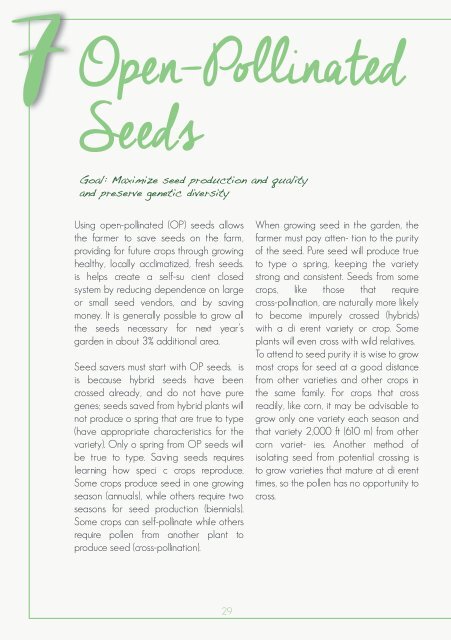Create successful ePaper yourself
Turn your PDF publications into a flip-book with our unique Google optimized e-Paper software.
Open-Pollinated<br />
Seeds<br />
Goal: Maximize seed production and quality<br />
and preserve genetic diversity<br />
Using open-pollinated (OP) seeds allows<br />
the farmer to save seeds on the farm,<br />
providing for future crops through growing<br />
healthy, locally acclimatized, fresh seeds.<br />
is helps create a self-su cient closed<br />
system by reducing dependence on large<br />
or small seed vendors, and by saving<br />
money. It is generally possible to grow all<br />
the seeds necessary for next year’s<br />
garden in about 3% additional area.<br />
Seed savers must start with OP seeds. is<br />
is because hybrid seeds have been<br />
crossed already, and do not have pure<br />
genes; seeds saved from hybrid plants will<br />
not produce o spring that are true to type<br />
(have appropriate characteristics for the<br />
variety). Only o spring from OP seeds will<br />
be true to type. Saving seeds requires<br />
learning how speci c crops reproduce.<br />
Some crops produce seed in one growing<br />
season (annuals), while others require two<br />
seasons for seed production (biennials).<br />
Some crops can self-pollinate while others<br />
require pollen from another plant to<br />
produce seed (cross-pollination).<br />
When growing seed in the garden, the<br />
farmer must pay atten- tion to the purity<br />
of the seed. Pure seed will produce true<br />
to type o spring, keeping the variety<br />
strong and consistent. Seeds from some<br />
crops, like those that require<br />
cross-pollination, are naturally more likely<br />
to become impurely crossed (hybrids)<br />
with a di erent variety or crop. Some<br />
plants will even cross with wild relatives.<br />
To attend to seed purity it is wise to grow<br />
most crops for seed at a good distance<br />
from other varieties and other crops in<br />
the same family. For crops that cross<br />
readily, like corn, it may be advisable to<br />
grow only one variety each season and<br />
that variety 2,000 ft (610 m) from other<br />
corn variet- ies. Another method of<br />
isolating seed from potential crossing is<br />
to grow varieties that mature at di erent<br />
times, so the pollen has no opportunity to<br />
cross.<br />
29







